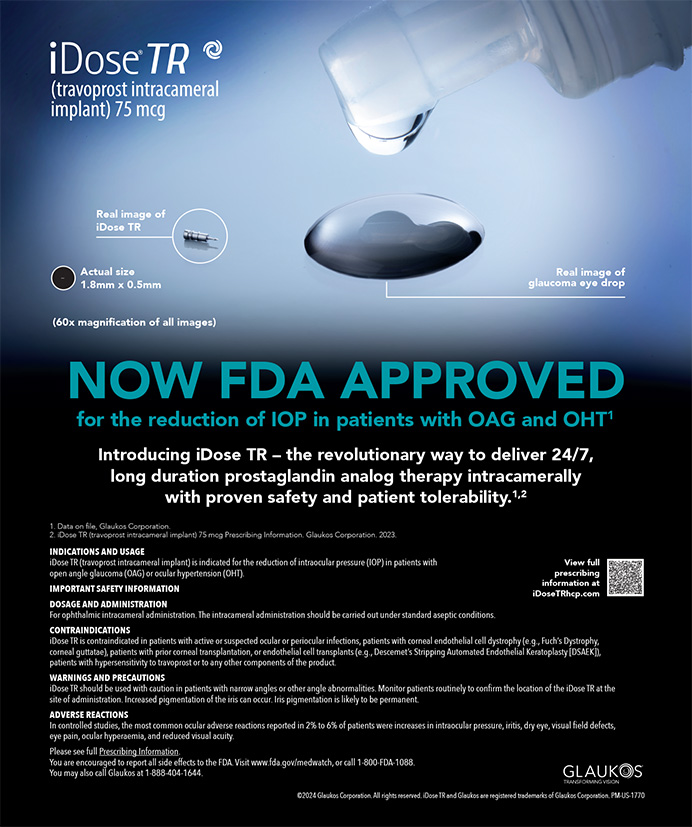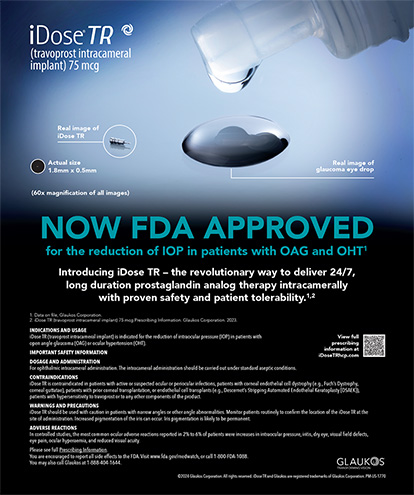I am increasingly impressed by the knowledge and sophistication of people who seek refractive cataract surgery. Some time ago, I received an e-mail message from an artist in Hawaii. I was amazed by her knowledge of the refractive cataract surgery market. She had read a few of my comments in various ophthalmic journals on the Tecnis Multifocal IOL (Advanced Medical Optics, Inc., Santa Ana, CA) and other multifocal and accommodating lenses, and she had also researched cataract surgical procedures in many ophthalmic trade publications. After I answered several of her questions and we discussed different options for cataract surgery via e-mail and over the phone, this woman agreed to come to my practice for treatment in November 2008.
THE CASE
According to the 66-year-old patient, she had undergone LASIK in January 2000 for monovision. Her dominant right eye was refracted for distance vision and her left eye for near vision. She received an enhancement in her right eye 12 months after the original LASIK surgery.
Her current spectacles were intentionally undercorrected for comfort and were 1.5 years old (Table 1). Within the past 8 months, the blurriness of her vision had increased noticeably. She currently wore glasses 100% of the time for computer use, 40% of the time for daytime driving, and 100% of the time for nighttime driving. Because of her visual quality, she only drove in familiar areas.
During a phone conversation with the patient, I reviewed her various options for cataract surgery, including multifocal, accommodating, and aspheric lens designs. She seemed to be leaning toward monovision (which she was already experiencing) with her near eye targeted to about the distance of her easel for painting (-1.50 D).
For simplicity and optimal functionality, the patient initially chose to undergo cataract surgery and to have the Tecnis 1-piece IOL (Advanced Medical Optics, Inc.) implanted in her worse-seeing (right) eye first to boost her intermediate range of vision, particularly for computer use and daily functioning. If necessary, I could enhance the distance vision in that eye postoperatively with an excimer laser procedure or possibly a piggyback IOL.
When the patient presented to my office for a cataract surgery evaluation, she complained of moderately blurry vision and glare in both eyes. Without correction, her distance vision was 20/100- OD and 20/100- OS, and her near vision was J10 in both eyes. With spectacle correction, her distance vision was 20/80 in both eyes.
The examination was normal except for bilateral cataracts, vitreous detachments, and a small patch of lattice degeneration in her right eye. Again, we discussed her surgical options, and I explained that unaided visual acuity with presbyopia-correcting IOLs usually improves for up to 1 year postoperatively. We also talked about her history of LASIK and how it might interfere with the IOL power calculation.
After a thorough conversation, the patient confirmed her choice of monovision with aspheric IOLs to obtain the best-quality image with minimal aberrations. We booked phacoemulsification and monofocal aspheric IOL implantation in her right eye with a targeted refraction of plano and discussed the possibility of a future phacoemulsification with IOL implantation in her left eye that would be targeted for vision in the intermediate-to-near range (-1.50 D).
THE PROCEDURE
Biometry with the IOLMaster (Carl Zeiss Meditec, Inc., Dublin, CA) on the patient's right eye showed remarkably long axial lengths and a relatively flat keratometry, both of which were due to the patient's prior LASIK procedure (Figure 1). The topography from the EyeSys system (EyeSys Technologies, Inc., Houston, TX) (Figure 2), which I confirmed with the Humphrey Atlas tomographer (Carl Zeiss Meditec, Inc.), was consistent with normal post-LASIK corneas. The Vol-Ct software (Sarver & Associates, Inc., Carbondale, IL) detected corneal spherical aberration in both eyes that was highly positive (0.545 µm OD and 0.510 µm OS), indicating a best fit with the Tecnis 1-piece IOL. The Holladay Diagnostic Summary (Holladay Consulting, Inc., Bellaire, TX) reported an effective refractive power of 38.05 D OD and 40.02 D OS. I entered all these data into the Holladay IOL Consultant software (Holladay Consulting, Inc.) as well as the post-LASIK IOL calculator, which is available at http://iol.ascrs.org. For the patient's right eye, with a target of plano, I chose an 18.00 D ZCB00 (Tecnis 1-piece) IOL. I did not want to use an extreme value (18.56 D was the maximum calculated), but I almost always prefer a myopic to a hyperopic residual refractive error.
The day after surgery, the patient returned to my practice very happy with 20/20 uncorrected distance visual acuity and asked to have her other eye corrected as soon as possible.
We had a myopic goal for the left eye, and I planned to perform limbal relaxing incisions to correct the modest amount of corneal astigmatism. The post-LASIK IOL calculator was pushing me toward an 18.00 to 18.50 D IOL in this eye, but the Holladay report suggested that an 18.50 D IOL would be too strong. In the end, I chose the 18.00 D lens. The limbal relaxing incisions were based on my extension of the Nichamin nomogram to correct with-the-rule astigmatism beginning at 0.50 D.1
The second surgery was uncomplicated, and the patient returned the next day for a postoperative examination. Her acuity measured 20/60 at distance and J1 at near.
RESULTS
At 3 months postoperatively, the patient's uncorrected distance visual acuity measured 20/20 OD and 20/40+ OS. The patient's uncorrected near vision measured J7 OD and J1 OS. Binocularly, she read 20/20 at J1. Her manifest refraction was plano sphere OD (20/20) and -1.00 D sphere OS (20/20).
CONCLUSION
Three months after the patient underwent her second surgery, she returned to my office and noted an occasional pulling sensation in her left eye. She was completely independent of spectacles and had created a gorgeous floral watercolor painting for me! As it turned out, the 18.50 D IOL in her left eye would have provided a result closer to the target, but it might also have increased her asthenopia. In all, I was very happy with the outcome, and so was the patient.
Mark Packer, MD, is a clinical associate professor of ophthalmology at the Casey Eye Institute, Oregon Health & Science University, and he is in private practice at Drs. Fine, Hoffman, & Packer, Eugene, Oregon. He is a consultant to and has received research funding from Advanced Medical Optics, Inc., and he is a consultant to Carl Zeiss Meditec, Inc. Dr. Packer may be reached at (541) 687-2110; mpacker@finemd.com.
- Nichamin LD. Management of astigmatism in conjunction with clear corneal phaco surgery. http://www.mastel.com/pdf/napa.pdf. Accessed September 9, 2008.


